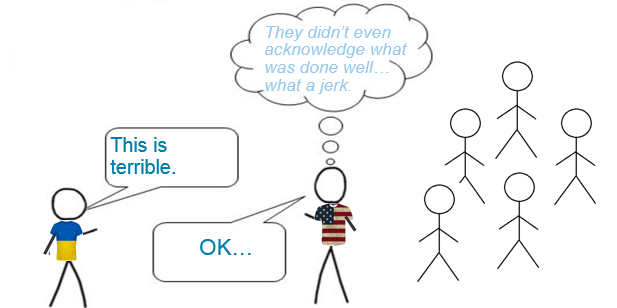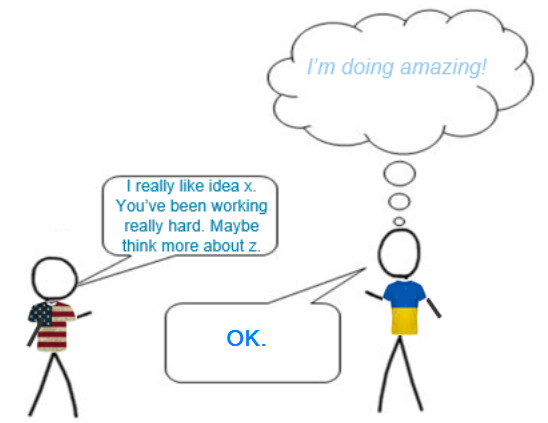Working on a team that is globally distributed is a great experience which also presents opportunities for deeper analysis and understanding. Since SPS is a multi-national, and thus multi-cultural, company, I will be writing eight individual blog posts which follow the eight scales of cultures outlined in Erin Meyer’s book, The Culture Map. For my Minnesotan and Canadian colleagues, don’t run away after reading this, but this post will focus on how different cultures provide negative feedback (coined Evaluating in The Culture Map). Trust me, it’s safe to read on.
Much of this content is either directly taken from, or is a summary of, Chapter 2 of The Culture Map, with some examples added for clarity. I’ve personally benefited from having this book available in my team’s “library” and hope that some of my learnings will be beneficial to others.
The Evaluating Scale: How Negative Feedback is Provided
- Direct Negative Feedback: Negative feedback is frank, blunt, & honest. Negative messages stand alone (not softened with positive messages). Absolute descriptors are common (“always”, “never”, “absolutely”, etc). Criticism may be given to an individual in front of a group.
- Indirect Negative Feedback: Negative feedback is soft, subtle, & diplomatic. Positive messages are used to “wrap” (or soften) negative ones. Qualifying descriptors are common (“sort of”, “maybe”, “slightly”, etc). Criticism is given only in private.
For a breakdown of where SPS’s offices fall on the Evaluating Scale (Direct vs. Indirect Negative Feedback), see below:

Direct Negative Feedback <————-> Indirect Negative Feedback
Note: Countries represented: US = Unites States, AU = Australia, CA = Canada, UA = Ukraine, IN = India. These are the locations that I work most closely with, though we have team members in other global locations as well.
Low Context != Direct Negative Feedback & High Context != Indirect Negative Feedback
If you read my last post on Communicating, then you might be surprised to see that Ukrainians are on the far end of the direct negative feedback scale and that Americans and Canadians are on the Indirect side of the scale. It should be pointed out that just because a culture (like Ukraine) tends to have a high context communication style (sophisticated, nuanced, between the lines) does NOT mean that they will thus be indirect with their negative feedback. Similarly, just because a culture (like the US and Canada) tend toward a low-context communication style (precise, simple, clear) does NOT mean that they will thus be direct with their negative feedback.
How Others Might Perceive You…How Misperceptions Arise
Direct Feedback Cultures
- Others can have a perception that Ukrainians (and other direct feedback cultures) are rude, mean, harsh (“Why does this person only ever seem to point out the mistakes I make and never recognize the contributions I provide?”)
- There can also be a perception that something is a personal attack if negative feedback is given with others present (it’s also really uncomfortable for your indirect feedback colleagues when this happens)

In this example, the Ukrainian is simply communicating that your idea/work is bad (so that you can change it). They’re NOT attacking you or your intelligence. This is how direct negative feedback works.
Indirect Feedback Cultures
- Others can have a perception that Americans (and other indirect feedback cultures) are false/dishonest or just plain confusing (“Why are you telling me so many things that are great, if you really want me to focus on something that I need to fix?”).

In this example, what the American really wants you to do is fix/correct/change whatever ‘z’ is. They’re just buffering that with positive statements so as to not be offensive. This is how indirect negative feedback works.
Being aware of these perceptions can help us to know both: 1) how we are perceived by others, and 2) how we are perceiving others so that we can adjust accordingly. This will often come through open dialogue with your team members so that you can better understand where the other is coming from when providing (or receiving) negative feedback. Without open dialogue, misperceptions can turn into held beliefs, which can turn into resentment of others. Don’t let this happen!
Disclaimer: Remember, once again, when thinking about different evaluating styles of your team members, it’s all relative. Even though Canada and the US are similar on the evaluating scale, Canadians would likely still see Americans as being pretty frank/direct with negative feedback…maybe not as much for us Minnesotans, though. Therefore, it is worth reading all strategies below, as some colleagues will be more indirect and more direct than your culture.
Strategies for Working with Indirect Negative Feedback Cultures
Giving Feedback TO Indirect Feedback Colleagues:
- When providing an evaluation, be explicit and low-context with both positive & negative feedback → BUT, don’t jump straight to the negatives. Make sure you state something positive about the person/situation first. Note, these positive comments should still be honest & explicit.
- Try replacing “upgraders”/absolute statements with some qualifiers or “downgraders” (words to soften the feedback). For example, instead of saying something like “You always …” or “You never…”, try saying something like “It seems like you occasionally…” or “I’ve noticed that sometimes…” ← (I know, it’s weird).
- Work to eventually become balanced in the amount of positive and negative feedback you give.
- Only give negative feedback in private (not in front of others) → This includes private chats vs. Slack rooms. For less individualistic cultures (i.e. collectivistic cultures), like India, you should also apply this rule to positive feedback as it may make these co-workers uncomfortable being called out in any way in a public setting. Your American colleagues, however, love being praised in public, so keep it coming!
- If your colleague is also a high context individual, then try blurring the message, giving it slowly over time, and sharing over drinks/food (when possible)
Receiving Feedback FROM Indirect Feedback Colleagues:
- Remember that your colleagues aren’t intending to be false or confusing. We Americans have grown up being taught that the best way to give negative feedback is to couch it with loads of positive feedback and qualifying statements. That isn’t true for people who have grown up in a more direct negative feedback culture.
Strategies for Working with Direct Negative Feedback Cultures
Giving Feedback TO Direct Feedback Colleagues:
- Don’t try to “do it like they do” (in terms of “upgraders”, especially) → It’s possible to be too direct, and if you’re not from that culture, you won’t likely know what that line is. If anything, working in one “upgrader” may be safe (“You’re completely wrong.“, “That’s a terrible idea.“, etc). If unsure, don’t try to include upgraders. Keep it simple and just be more direct.
- Don’t use your fallback Compliiment Sandwich method (or 3 positives per negative) → This is confusing to your direct feedback colleagues, as it actually sounds like you’re telling the person they’re (doing) amazing!
- Try limiting your statements that could be seen as superfluous or exaggerations: For example, you don’t have to use so many “great”, “excellent”, “amazing”, “thrilled” type words → If you do, do so sparingly. Otherwise, you will again run the risk of being confusing or being seen as false with the feedback you’re giving.
Receiving Feedback FROM Direct Feedback Colleagues:
- Take messages literally and not personally → They’re not intended to be offensive; take the message at face value.
- Understand that direct negative feedback is a sign of honesty, transparency, and respect for your professionalism (i.e. you can handle it and you should want to hear it so that you can improve).
No matter who you are interacting with and what their cultural norm is…If it ever seems like something is unclear, ask clarifying questions until you are both on the same page. I.e. don’t assume that your message was received as it was intended to be. It’s better to seek clarity and know that you’re on the same page than to avoid doing so and fall into miscommunications, misunderstandings and poor feelings towards, or about, your colleague. Negative (constructive) feedback is a valuable part of helping one another to grow and develop. Hopefully using these tips you will feel more equipped to manage giving and receiving negative feedback with your cross-cultural peers.
Want to Read More?
Curious to read more? Check out my other articles, The Benefits of Global Diversification & Communicating Effectively Across Cultures. I’ll also be authoring articles on the remaining 6 scales of the Culture Map in the coming months, so keep your eyes out for those too!